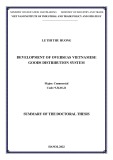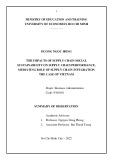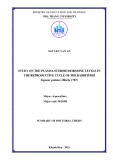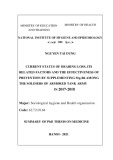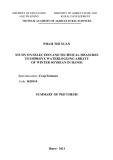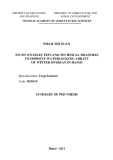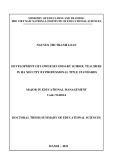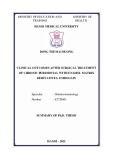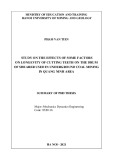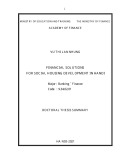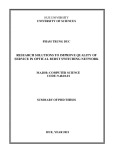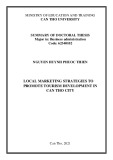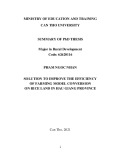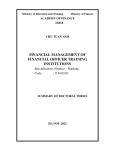INTRODUCTION
1. Rationale Corporations have many advantages in rasing fund by issuing bonds. is still small. The size of Vietnam corporate bond market Corporations mainly for existing issue convertible bonds shareholders or issue bonds in private form for certain partners. So, bondholders often hold bonds until due. As a result, there are almost no transactions in secondary corporate bond market. Therefore, study to increase the size of corporate bonds in Vietnam is necessary. There are many studies about corporate bond market in developed countries, such as United State, Korea, …. These corporate bond markets are developed and have large size. Besides, many researchers study about ermerging corporate bond markets in Asian or South East Asian. Their studies mainly focus on factors that affect to the market size. However, there are very few similar studies in Vietnam. The studies in Vietnam are often about Government bonds. In studies about corporate bonds, researchers always used descriptive statistics method. Meanwhile, the use of mathematical methods to identify or quantify the factors affecting the size of the market, as an important basis for developing market development solutions, should be implemented. In summary, the implementation of an in-depth study, which focuses on identifying the factors that influence the size of the corporate bond market in Vietnam, is a gap. Therefore, the topic "Factors affecting the size of Vietnam's corporate bond market" was selected for research. 2. Objectives (i) Assess the status of the impact of factors on the size of Vietnam's corporate bond market. (ii) Propose some recommendations to increase the size of Vietnam's corporate bond market. Research questions: (i) Are there any factors affecting the size of the corporate bond market in general and the corporate bond market in Vietnam in particular? (ii) How is the impact of these factors on the size of the corporate bond market in Vietnam? (iii) Measures to increase the scale of Vietnam's corporate bond market based on these factors? 3. Research subjects The size of the Vietnamese corporate bond market and the factors affecting the size of the market. The thesis focuses on issued bonds and listed bonds traded on the secondary market. 4. Research scope 4.1. Vietnam primary corporate bond market Macro – factors affect the size of Vietnam primary corporate bond market in 2005 – 2018 4.2. Vietnam secondary corporate bond market Factors affect the size of Vietnam secondary corporate bond market in 2012 – 2017 5. Methodology (1) Descriptive statistics: sort and describe the data about issuance volume, trading volume and impact factors of corporate bonds. (2) Regression models: The thesis uses secondary data and some econometric models and econometric software (Eviews and Stata) to estimate the correlation between factors affecting the size of Vietnam's corporate bond market and the impact of these factors. 6. New contributions of the thesis 6.1. In terms of theory Firstly, the thesis has developed a model for testing factors affecting the issuance volume of corporate bonds and conducting testing for the market of primary corporate bonds in Vietnam. Tested factors include: (1) the size of the economy, (2) the openness of the economy, (3) the development stage of the economy, (4) the size of the banking system, (5) interest rate variability, (6) exchange rate variability, (7) foreign exchange reserves and (8) creditors' rights. The thesis also uses the value of bonds issued more in each quarter as a scale for issuance scale instead of the current bond value. The data used is time series data corresponding to the size of quarterly bond issuance in the period 2005 - 2018. Secondly, the thesis is the first research in Vietnam to test the factors affecting the trading volume of listed corporate bonds. Tested factors include: (1) issuance volume, (2) age, (3) default risk, (4) profit volatility and (5) stocks’ trading volume. The data used is panel data, corresponding to 28 listed bonds traded during 2012-2017.
1
2
national stage of development, the greater the corporate bond market (cid:1) Interest rate variability. The larger interest rate variablility will increase the risk of long-term assets in the financial market, especially corporate bonds and the size of the corporate bond market will decrease.
6.2. In terms of practice The result shows that the size of the economy, the openness of the economy, the size of the banking system, exchange rate variability, foreign exchange reserves and creditors' rights are factors that affect tothe issuance volume of corporate bonds in Vietnam. In secondary market, age, credit risk, profit volatility, stocks’ trading volume are factors that affect to trading volume of listed corporate bonds.
(cid:1) The size of banking system. In some cases, the larger the banking system, the less developed the corporate bond market. However, in an open economy, commercial banks now become the necessary subjects to promote the development of the corporate bond market.
(cid:1) Exchange rate variability. (cid:1) Foreign exchange reserves. Increasing of the level of foreign exchange reserves will lead to the development of corporate bond market.
(cid:1) Creditors’ rights. Countries that have strong creditors’ rights will promote the increasing of the size of corporate bond market. 1.1.3.2. Factors affecting to the size of secondary corporate bond market (cid:1) Issuance Volume. Higher issuance volume, higher trading transactions. (cid:1) Bond’s age. Bonds issued in the latest time period will be traded most often. (cid:1) CHAPTER 1: THE BASIC OF THEORY AND LITERATURE REVIEW 1.1. The basic of theory about facors affecting the size of corporate bond market 1.1.1. Structure of corporate bond market 1.1.2. The size of corporate bond market 1.1.2.1. Conceptions about the size of corporate bond market According to Oxford dictionary: “Size is how large or small something or someone”. Therefore, it can be understood that the size of the corporate bond market is how large or small of market. Because the corporate bond market includes both primary and secondary markets, the size of the primary market is considered through the issuance volume and the size in the secondary market is shown by liquidity (Mizen and Tsoukas, 2014). 1.1.2.2. Measurement of the size of corporate bond market Primary bond market (cid:1) Credit risk. Investors do not want to invest to bonds that have high credit risk. Issuance volume = Total value of outstanding bonds/GDP (1) Issuance volume = Total value of bonds issued (2) (cid:1) Secondary bond market (cid:1) Profit volatility. (cid:1) Stock’s trading volume.
Eichengreen of corporate (i) Number of transactions (3) (ii) Number of bonds traded (4) (iii) Turnover (5) 1.1.3. Factors affecting to the size of corporate bond market 1.1.3.1. Factors affecting to the size of primary corporate bond market (cid:1) The size of economy. The small economy often lack useful tools for growing bond market. (cid:1) The openness of the economy. Economies with large openness usually have more development corporate bond markets. (cid:1) The development stage of the economy. The higher the
3
1.2. Literature review 1.2.1. Foreign studies Research by Hawkins (2002) has made a multi-dimensional assessment of the relationship between the banking system and the and size bond market. Luengnaruemitchai (2004) tested 15 factors affecting the size of the bond market. The results show that the size of the economy, the size of the banking system, the exchange rate, compliance with international accounting standards, corruption and state management are factors that influence the bond market of Asian countries. Research by Bhattacharyay (2013) focused on understanding the 4
correlation between the size of the bond market and the macro factors. The testing results for corporate bonds show that the issuance volume of the corporate bond market is affected by factors: the size of the economy, the openness of the economy, the size of the banking system, the stage of development of the economy and interest rate variability. Kowalewski and Pisany (2017) suggested that creditors' rights and market size are positively related. Mizen and Tsoukas (2014) studied the factors affecting the issuance decision of businesses. In this study, the authors believe that there are both macro and micro factors that influence corporate decision making. The results show that the size and growth of revenue of the business has a positive relationship with the size of the issuance. The regression results of Braun and Briones (2006)’s study showed that the most important factor determining the size of the market. Bond is the level of economic development, or GDP per capita. The size of the banking system and the creditors' rights also have a positive relationship with the size of the bond market. Focusing on emerging economies, a study by Tendulkar (2015) concluded that international corporate bond size is affected by GDP per capita, number of listed enterprises, and domestic credit and interest rate variability. The total size of the corporate bond market is affected by the size of the government bond market, the number of listed companies, interest rate spreads, domestic credit, CPI and hedging premiums. Mu et al. (2013) suggested that domestic credit has a positive effect, interest rate variability have a negative relationship to the size of the African corporate bond market. Fredrick's (2014) showed different results. Accordingly, only the exchange rate, interest rate fluctuations, the size of the economy and average income affect to the size of the corporate bond market. Another similar study was conducted in the Indian corporate bond market by Maurya and Mishra (2016) which also gave conclusions that are not very similar to those of previous emerging market studies. According to Maurya and Mishra (2016), the Indian corporate bond market was most significantly affected by foreign exchange reserves. Study of Alexander et al. (2000) focused on testing factors that affect trading volume of high – yield corporate bonds. The results showed that issuance volume and bonds’age are two factors that have strong impact on trading volume of these bonds. Alexander et al. (2000) 5 supposed that bonds within 2 years of issuance are traded the most. Besides, this study also showed that credit risk and profit volatility all have positive impact to trading volume. In contrast, Wahyudi and Robbi (2009) mentioned that issuance volume has a negative impact to trading volume. Hotchkiss and Jostova (2007) expanded the scope of research, confirmed that issuance volume and age have strong impact to trading volume of corporate bonds. 1.2.2. Studies in Vietnam Tran Thi Thanh Tu (2007) used descriptive statistic method to compare and analyze data on Vietnam corporate bond market in the period of 2003 - 2007. According to the author, most of corporate bonds were issued at that time were long-term bonds, and they belong to State enterprises or big enterprises. The secondary bond market has almost no bonds traded. Trinh Mai Van (2010) and Phan Thi Thu Hien (2014) suggested that the lack of legal framework on corporate bonds and information transparency was reason of the underdevelopment of the corporate bond market in Vietnam. The research of Vuong and Tran (2010) analyzed Vietnam corporate bond market in the period of 1992 – 2009 with a large dataset from different aspects. They confirmed that the issuance of corporate bonds focused on large enterprises, mainly state-owned enterprises and the competition of state-owned enterprises limited the ability to raise debt of SMEs. Stuydy of HNX (2016) also described the current situation of the market in recent years. Nguyen Thi Nhung and Tran Thi Thanh Tu (2019) gathered 11 groups of criteria to assess the liquidity of corporate bond market. In particular, size of issuance, outstanding debts of corporate bonds market, growth speed of corporate bonds in circulation are used to measure the liquidity of primary bond market and volume of corporate bonds traded and coefficient rotation are used to measure the liquidity of secondary bond market in Viet Nam. This research compared these criteria’s data of Vietnam and some other countries to assess the liquidity of Vietnam bond market. Research of Nguyen Hoa Nhan et al. (2014) is the first research in Vietnam that uses regression analysis method to analyzie the relationship between the issuance volume of corporate bonds and some macro – factors. This study showed that the openness of economy, the size of banking system and issuance volume in last 6
2.3.2. The secondary corporate bond market (cid:1) Trading
Corporate bonds are traded in 2 ways: (1) at stock exchange and (2) OTC period have positive impact to the issuance volume in this period. In contrast, exchange rate and the stage of development of the economy have negative impact to the issuance volume of corporate bonds in Vietnam. (cid:1) Size of market 1.2.3. Research gaps
In the period of 2012 - 2015, the trading volume was only a few trillion, an average of over 3.8 trillion per year, in 2016 reached over 10 trillion. In the period of of 2016 - 2017, each year there were average of 7 trillion worth of corporate bonds trading on the secondary market. 2.4. Policies to develop corporate bond market in some other countries. CHAPTER 3: METHODOLOGY
3.1. Research framework and models 3.2. Methodology 3.2.1. Descriptive satistics 3.2.2. Regression analysis 3.2.2.1. Regression analysis for time series data (cid:1) The stationary of time series data Tại Việt Nam, các nghiên cứu về TPDN chủ yếu ở dạng thống kê, mô tả số liệu và có rất ít nghiên cứu về các yếu tố tác động tới quy mô thị trường TPDN. Đối với quy mô của thị trường TPDN sơ cấp, nghiên cứu của Nguyễn Hòa Nhân và cộng sự (2014) là nghiên cứu đầu tiên sử dụng mô hình phân tích hồi quy. Tuy nhiên, các yếu tố được phân tích trong nghiên cứu còn ít và tỷ lệ phần trăm giải thích sự biến động của biến phụ thuộc thông qua biến độc lập còn thấp. Có thể xem xét thêm nhiều yếu tố khác để xác định thêm các yếu tố tác động tới quy mô phát hành TPDN Việt Nam. Ngoài ra, nghiên cứu về quy mô thị trường TPDN Việt Nam chủ yếu tập trung vào quy mô phát hành. Quy mô giao dịch của TPDN trên thị trường thứ cấp là vấn đề ít được nghiên cứu. Đặc biệt là chưa có nghiên cứu nào sử dụng mô hình hồi quy để xem xét các yếu tố tác động tới quy mô giao dịch của TPDN Việt Nam.
CHAPTER 2: THE REAL SITUATION OF VIETNAM CORPORATE BOND MARKET >
Augmented Dickey – Fuller (ADF) test is used to test the stationary of variables. If at significant levels of 1%, 5% and 10%, variables are stationary at the corresponding significant levels (Levin et al., 2002). (cid:1) Regression analysis 2.1. Overview of Vietnam’s economic environment in the period of 2005 – 2017 2.2. Overview of Vietnam corporate bond market 2.3. The structure of Vietnam corporate bond market 2.3.1. The primary cororate bond market (cid:1) Issuance volume Data of factors affect the issuance volume is quarterly data and it is called time series data. In which, t is used to refer time points in the series. Model of time series data is as follow (Nguyen Quang Dong and Nguyen Thi Minh, 2013): (a) The annual issuance volume greatly affects the size of the market. It can be seen that the annual issuance volume of corporate bond in Vietnam has tended to increase in the period of 2005 - 2018, from over VND 137 billion in 2005 to over VND 40,000 billion in 2018. (cid:1) Terms of bond Because (a) is a linear regression model, it will be estimated by the least square method (Ordinary Least Square - OLS). When the assumptions are satisfied, the estimation results are reliable.
(cid:1) Test for specification errors for specification errors: multicollinearity, multivariate
Test normality, autocorrelation, homoscedasticity, functional form. 3.2.2.2. Regression analysis for panel dât (cid:1) Regression methods
Terms of corporate bonds in Vietnam are very diverse, ranging from 1 to 20 years, depending on the target and issuance conditions. In cases of supplementing NWC, or debt restructuring, firms will raise short – term loans (<3 years). Loans for financing projects will be more than 3 years, or more than 5 years. In general, in the period of 2005 - 2018, the average term of corporate bonds of less than 3 years. 7
8
Data of factors affect to trading volume is panel data. According to Baltagi (2005), panel data model is as follow:
(b) Model without :
Interest (iv) Profit variability is measure as fluctuation of VWAP. (v) Stock’s trading volume is secondary data that is collected from finance.tvsi.com.vn/data 3.4. The process of testing 3.4.1. Factors affect to issuance volume (i) Test the stationary of time series data (ADF test) (ii) Estimate model by using OLS and test the model’s errors. (iii)Test for specification errors: multicollinearity (VIF), multivariate normality (Jarque – Bera test), autocorrelation (Breusch-Godfrey test), homoscedasticity (Breusch – Pagan – Godfrey test and White test), functional form (Ramsey test). (iv) If model has errors, remedies will be performed. 3.4.2. Factors affect to trading volume (i) Test the stationary of panel data (ii) Analyze the correlation between variables. (iii) Using Breusch – Pagan test to find out the most suitable estimation method for panel data. (iv) If prob > 0.1: using POLS. (v) If prob < 0.1: using Hausman test to test the correlation between and independent variables. If Prob < 0.1: using FEM; if prob > 0.1: using REM
CHAPTER 4: ANALYZE FACTORS THAT EFFECT TO THE SIZE OF VIETNAM CORPORATE BOND MARKET
4.1. Factors affect to primary corporate bond market 4.1.1. Variables and measurement Expected model:
(1) In which: t = 1, 2, ..., 56 represent for 4 quarters/year of the period from 2005 to 2018.
Model Variables Size (1) Symbol IVOL in
Table 4.1: Variables and Measurement of model (1) Measurement Issuance volume each quarter Log(GDP) Unit Billions VND % GDP (1) (c) , there are 3 estimation methods: Pooled OLS – Depending on POLS, Random Effects Model – REM and Fixed Effects Model – FEM. 3.3. Dataset 3.3.1. Dataset of factors affect to issuance volume (i) Data of issuance volume is secondary data that is collected quarterly from website Asianbondsonline.adb.org in the period of 2005 – 2018. (ii) The size of economy (Measurement as GDP), the openness of economy (Measurement as Experts) are secondary data that are collected from website finance.vietstock.vn. GDP is a non-linear data so it will be taken as a logarithm. the size of banking system rate variability, (iii) (Measurement as domestic credit), exchange rate variability and foreign exchange reserves are secondary data that are collected quarterly from website data.imf.org in the period of 2005 – 2018. (iv) The stage of development of economy (Measurement as GDP per capita) is secondary data that is collected yearly from website data.worldbank.org in the period of 2005 – 2018 and is interpolated in quarterly data. GDP per capita is a non-linear data so it will be taken as a logarithm. (v) Creditors’ right is analyzed and calculated basing on Djankov et al. (2007) and Laws of bankruptcy 1993, 2004, 2014 of Vietnam. 3.3.2. Dataset of factors affect to trading volume (i) Trading volume is primary data that is collected monthly from HSX in the period of 2012 – 2017. (ii) Bond’s age is based on time of issuance. (iii) Credit rating of issuers is used to measure default risk of bonds because corporate bonds have not rated in Vietnam. Credit rating of issuers is secondary data that is collected from CIC. The size of economy
9
10
Measurement Unit (1) Exports Symbol EXPRT %
(1) PGDP
Model Variables The openness of economy The stage of development of economy Coefficient Std. Error t-Statistic Prob.
(1) DRATE %
(1) Log(GDP per capita). is GDP per capita interpolated in quarterly data Leding interest rate – Deposit interest rate Domestic credit CREDIT Millions VND
(1) EXR VND/USD Average exchange rate in quarter
(1) exchange FER 1339.511 2.82E+02 0.017436 -483.992 0.037872 -5.31E+01 -0.051366 1.47E-02 65.55346 1675.374 1.35E+02 0.008629 367.7746 0.011563 4.83E+01 0.042415 4.74E-03 94.01795 0.79953 2.085928 2.020693 -1.316 3.275279 -1.09984 -1.21106 3.109871 0.697244 Foreign reserves Millions USD
(1) RIGHTS 0 4 Interest rate variablility The size of banking system Exchange rate variability Foreign exchange reserves Creditors’ right – scores (weak
The index ranges from 0 creditor rights) to 4 (strong creditor rights 2012 – 2014: 1 score; 2015 – 2017: 2 scores Dependent Variable: IVOL Method: Least Squares Sample (adjusted): 2005Q2 2018Q4 Included observations: 55 after adjustments Variable C LOG(GDP) D(EXPRT) LOG(PGDP) CREDIT DRATE EXR FER RIGHTS R-squared Adjusted R-squared S.E. of regression Sum squared resid Log likelihood F-statistic Prob(F-statistic) 0.4281 0.0426(**) 0.0492(**) 0.1947 0.002(***) 0.2771 0.2321 0.0032(***) 0.4892 0.53508 0.454225 150.381 1040264 -348.852 6.617725 0.00001
(Source: Author’s calculations) In which: (*): significant at 10%, (**): significant at 5%, (***): significant at 1%. Prob(F-statistic) of model (1.1) = 0.00001 < 0.05 (cid:1) Test the errors of model (1.1)
4.1.2. Descriptive statistics 4.1.3. Test factors affect to the issuance volume 4.1.3.1. The stationary of time series data Data of variables is tested the stationary on EVIEWS. The results show that IVOL is stationary at 0 level (10%), log(PGDP) is stationary at 0 level (1%), EXPRT is stationary at 2 level and other variables are stationary at 1 level. 4.1.3.2. Regression analysis of model (1.1) (cid:1) The results of regression analysis of model (1.1) The results show that model (1.1) do not have errors except multicollinearity because VIF index of some variables are more than 10. So that, variable with high VIF index is removed off model (1.1). New model is as follow:
11
12
(1.2) 4.1.3.3. Regression analysis of model (1.2) (cid:1) The results of regression analysis of model (1.2) (1.3) 4.1.3.4. Regression analysis of model (1.3) (cid:1) The results of regression analysis of model (1.3)
Prob.
Prob. t-Statistic Coefficient Std. Error t-Statistic -4.88E-01 1.643388 2.23984
891.742 115.5235 0.008361 0.010275 0.021453 0.003649 73.69839 -609.552 206.748 0.018589 0.041407 -0.10087 0.010688 143.6858 -0.68355 1.789661 2.223195 4.0298 -4.70171 2.929367 1.949646
Dependent Variable: IVOL Method: Least Squares Sample (adjusted): 2005Q2 2018Q4 Included observations: 55 after adjustments Variable Coefficient Std. Error 9.64E+02 -470.421 C 119.4337 196.2759 LOG(GDP) 0.008586 0.019231 D(EXPRT) 0.0116 0.039318 CREDIT 39.40295 -15.8087 DRATE 0.022044 -0.09919 EXR 0.003688 0.010778 FER RIGHTS 80.00656 131.8318 R-squared Adjusted R-squared S.E. of regression Sum squared resid Log likelihood F-statistic Prob(F-statistic)
Dependent Variable: IVOL Method: Least Squares Date: 12/17/19 Time: 14:00 Sample (adjusted): 2005Q2 2018Q4 Included observations: 55 after adjustments Variable C LOG(GDP) D(EXPRT) CREDIT EXR FER RIGHTS R-squared Adjusted R-squared S.E. of regression Sum squared resid Log likelihood F-statistic Prob(F-statistic)
0.4975 0.0798(*) 0.0309(**) 0.0002(***) 0.0000(***) 0.0052(***) 0.0571(*) 0.515924 0.455415 150.2169 1083126 -349.962 8.526337 0.000003 (Source: Author’s calculations) In which: (*): significant at 10%, (**): significant at 5%, (***): significant at 1%. Prob(F-statistic) of model (1.3) = 0.000003 < 0.05 0.6279 0.107 0.0299(**) 3.389591 0.0014(***) 0.6901 -0.40121 -4.49945 0.000(***) 2.922729 0.0053(***) 0.1061 1.647762 0.517576 0.445726 151.5473 1079429 -349.868 7.203536 0.000007 (Source: Author’s calculations) In which: (*): significant at 10%, (**): significant at 5%, (***): significant at 1%. Prob(F-statistic) of model (1.2) = 0.000007 < 0.05 Log(GDP), DRATE and RIGHTS have prob. > 0.1 and they are not significant at 10%. (cid:1) Test errors of model (1.2) Test errors of model (1.3) (cid:1) The results show that model (1.3) do not have errors. The last model is as follow: The results show that model (1.2) do not have errors. Because Prob. of DRATE is more than 0.1, this variable is removed off. New model is as follow: IVOLt = - 609.552 + 206748Log(GDP)t + 0.018589D(EXPRT)t + 0.041407CREDIT – 0.10087EXRt + 0.010688FERt +
13
14
143.6858RIGHTSt (1.3) volume
(2) Age AGE
volume in par value Number of months since issuance
(2) Default risk Firm’s credit rating Qualitative variable AGE_1: more than 2 years AGE_2: in years AGE_3: Unreleased/Expired RATING Qualitative variable In
In
not 4.1.3.5. Discuss the research’s results (i) The stage of development of the economy (PGDP) and the interest rate variability (DRATE) have no impact on the issuance volume of corporate bonds. (ii) The size of the economy (GDP), the openness of the economy (EXPRT) and the size of the banking system (CREDIT) have a positive impact on the issuance volume of corporate bonds. (iii) Exchange rate fluctuations (EXR) have a negative impact on the issuance volume. (iv) Foreign exchange reserves (FER) have a positive impact on the volume of corporate bond issuance. (v) Creditors' rights (RIGHTS) have a positive impact on issuance volume. 4.2. Factors affect to trading volume 4.2.1. Variables and measurement Expected models: RATING_1: rank A RATING_2: rank B RATING_3: rated (2) DVWAP % Profit variability (2.1)
(2.2) (2) Billions VND SVOL
(2.3) In which: i = 1, 2, ..., 28 (represent for 28 bonds), t = 1, 2, …, 72 corresponds with 12 months/year in the period of 2012 – 2017.
Model Variables Measurement Symbol Table 4.4: Variales and measurement of model (2) Unit Transaction TIMES (2) Trading volume Volume Weighted Average Price (VWAP) variability Value of stock Stock’s traded in trading month volume 4.2.2. Descriptive statistics 4.2.3. Test factors affect to trading volume 4.2.3.1. Test the staytionary of panel data Levin – Lin – Chu (LLC) test is used to test the stationary of panel data. The rusults show that SVOL is stationary at 0 level (1%) and other variables’ data are stationary at 1 level (1%). 4.2.3.2. Correlation analysis NBOND Bond (cid:1) The correlation between dependent variables
(1) Number of transactions in month (2) Number of are bonds traded in month The correlation between TIMES, NBOND and TOVER is quite tight because the correlation coefficient is approximately 0.7. So that, TIMES, NBOND and TOVER are suitable to measure the trading volume. (3) Turnover TOVER Billions VND (cid:1) The correlation between independent variables The absolut of correlation coefficients between independent are less (2) Issuance Issuance SIZE Thousands VND
15
16
than 0.7. This shows that model (2) does not have multicollinearity. (cid:1) The correlation between independent variables and dependent variables
The correlation between the independent variables and the dependent variables is very low due to the correlation coefficient is less than 0.7.
4.2.3.2. Results Table 4.11: Methods are used to estimate model (2) TIMES NBOND TOVER
significant at 1%. Because all three models use the fixed effects model (FEM), the SIZE variable is removed from the models. Therefore, it is not possible to assess the impact of SIZE on the trading volume In 3 models, AGE_1, AGE_2, RATING_1 and RATING_2 are significant at 1% and have positive impact to dependent variables. The coefficient of these variables show that bonds are issued in 2 years and are rated in B category have bigger trading volume than others. In model (2.2) and model (2.3), SVOL variable has negative impact to NBOND and TOVER but DVWAP has positive impact to them. 4.2.3.3. Discuss the research’s results Test Breusch – Pagan Hausman Method Prob = 0.000 0.000 Prob = 0.000 0.0797 FEM 0.000 0.0412 FEM FEM (Soure: Athour’s calculations)
Dependent variables Methos R2 - overall P - value (i) Because SIZE did not change during the study period, it is removed in FEM. (ii) Bonds with age is less than 2 years are traded more than other bonds. (iii) Bonds with rank B have bigger trading volume than bonds with rank A. (iv) The greater the volatility of the bond's profit, the greater the trading volume. (v) The greater the issuers’ stocks traded, the less bonds traded. Table 4.12: Results of testing the R2 NBOND FEM 0.1274 0.000 TIMES FEM 0.3250 Prob. = 0.0000 CHAPTER 5: RECOMMENDATIONS TOVER FEM 0.1292 0.000 (Soure: Athour’s calculations) Table 4.13: Results of testing 3 models
TIMES
NBOND
TOVER
Variable
Coefficient
Prob
Coefficient
Prob
Coefficient
Prob
SIZE
0
X
0
X
0
X
AGE_1
3.073938
0.000(***)
578346.1
0.000(***)
58.74211
0.000(***)
AGE_2
7.341274
0.000(***)
1133685.0
0.000(***)
117.7666
0.000(***)
AGE_3
0
0
0
RATING_1
2.740408
0.000(***)
917450.6
0.000(***)
92.58299
0.000(***)
RATING_2
3.860852
0.000(***)
1148857.0
0.000(***)
116.9805
0.000(***)
RATING_3
0
0
0
DVWAP
0.0116864
0.265
6805.795
0.031(**)
0.7757046
0.016(**)
SVOL
– 0.0001556
0.183
– 136.1458
0.000(***)
– 0.0132649
0.000(***)
CONS
– 4.063231
0.000
– 1071589.0
0.000
– 109.8196
0.000
5.1. Development orientation of Vietnam's corporate bond market in the coming time 5.2. Recommendations 5.2.1. Economic growth, stabilizing exchange rates and increasing the size of foreign exchange reserves Growth is accompanied by curbing inflation, ensuring large balances, maintaining macroeconomic stability. It is necessary to strictly control and ensure that banks perform the policy on restricting foreign currency loans to enterprises. At the same time, it should license to some organizations that are allowed to trade in foreign exchange, to meet the needs of foreign exchange trading of businesses. 5.2.2. Promote the development of the banking system in terms of market makers Banks should be considered as market makers. They need to be motivated to play this role. 5.2.3. Establish professional credit rating organizations and rate corporate bonds (Soure: Athour’s calculations) In which: (*): significant at 10%, (**): significant at 5%, (***): 17
18
1. The successes Firstly, overview previous studies about the corporate bond market, the size of the corporate bond market and the factors affecting the size of the corporate bond market. Secondly, test econometric models and identify factors affecting the size of the corporate bond market in Vietnam. Thirdly, based on the results of testing the econometric model on the impact factors, propose some recommendations to increase the size of the corporate bond market in Vietnam. 2. The limitations (cid:1) Data Factors affect to issuance volume
Factors affect to trading volume
(cid:2) GDP per capita in Vietnam is only annualized and must use software to interpolate to quarterly figures. Interpolation and actual statistics may differ. (cid:2) Model about factors affect to trading volume is estimated by using data of listed corporate bonds. However, trading volume of listed bonds is very small compared with trading volume of whole secondary corporate bond market. Besides, credit rating of bonds is replaced by credit rating of issuers. In Vietnam, credit rating of businesses is updated 2 times/year. (cid:1) Models
Establish professional credit rating organizations. Banks which meet Basel Accords can establish subsidiaries that provide credit rating services. Government should issue regulations that require businesses to make credit rating on bonds before issuance. 5.2.4. Market control and information disclosure Information of bonds about credit rating, price, … should be publiced for investors. Regulations about information disclosure (for both public issuance and private issuance) should be issued. 5.2.5. Improve bondholder’s right The missing regulations should be added: (1) creditors may refuse or agree for the business's application for bankruptcy, (2) secured creditors can regain the mortgaged properties after the business apply for bankruptcy. 5.2.6. Revise and add reguations related to the corporate bond market In 2018, the Government issued Decree 163/2018 / ND - CP about corporate bond issuance. However, there are still some issues in Decree 163 that need to be adjusted. Regulators need to review laws in a comprehensive way, eliminate duplicated content and agree on conflicting content. 5.2.7. Upgrade technical infrastructure for corporate bond market The technology infrastructure of the corporate bond market in Vietnam still lacks a lot of tools to support market activities such as issuance registration / issuing license system; standard bid system or release survey support system; an online ISIN (international securities trading code) system; information listing system on bonds; bond pricing information system; National information system on corporate bonds.
In fact, there are many factors that affect the size of the primary corporate market. However, the thesis only focuses on studying the impact of macro factors without mentioning the micro - internal factors of enterprises. Therefore, the variables in the model only explain a small part of the fluctuation of the issuance volume of corporate bonds in Vietnam.
CONCLUSIONS The corporate bond market plays an important role in the socio- economic development of each country. Increasing the size of the corporate bond market will help businesses finance most of their activities, reduce dependence on the commercial banking system, limit risks of the financial market, and promote economic development. In order to develop appropriate solutions to increase the corporate market size, it is necessary to learn about the factors affecting the market size. The thesis has achieved the research objectives.


